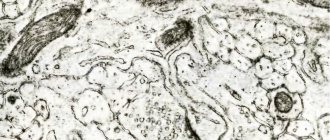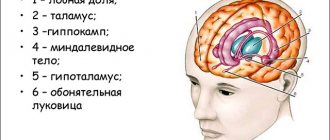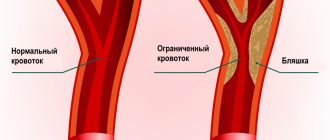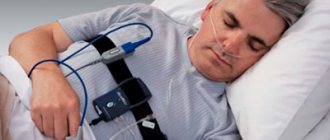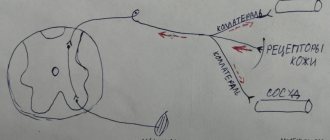Acetylcholine is the main neurotransmitter of the parasympathetic nervous system. It was the first molecule to be identified as a neurotransmitter. This is a chemical that neurons use to communicate with each other. It is also involved in many physiological functions such as regulation of heart rate and blood pressure, intestinal motility, glandular secretion, etc.
Neurotransmitters are usually divided into excitatory and inhibitory. Acetylcholine is unique in that it does not fall into any one group. It functions differently depending on its location and the type of receptors available. For example, in the muscles it has an stimulating effect, but in the heart it has an inhibitory effect.[]
Acetylcholine is produced from the essential nutritional choline, which humans obtain from food. Choline is an essential nutrient required by the body for fat metabolism, cell protection, nerve function and other biochemical reactions.
Cholinergic synapse[edit | edit code]
Source:
Visual Pharmacology
.
Author
: X. Lulman.
Per. with him. Ed.
: M.: Mir, 2008
Acetylcholine - Vyacheslav Dubynin (Doctor of Biological Sciences, M.V. Lomonosov Moscow State University)
Acetylcholine
(ACh) - a transmitter in postganglionic synapses - accumulates in high concentrations in the vesicles of the axoplasm of the nerve ending. ACh is formed from choline and activated acetic acid (acetyl coenzyme A) under the action of the enzyme acetylcholine transferase. Highly polar choline is actively taken up by the axoplasm. There is a special transport system on the membrane of the cholinergic axon and nerve endings. The mechanism of mediator release has not been fully disclosed. Vesicles are anchored in the cytoskeleton by the synapsin protein in such a way that their concentration near the presynaptic membrane is high, but there is no contact with the membrane. When excitation occurs, the Ca2+ concentration in the axoplasm increases, protein kinases are activated, and phosphorylation of synapsin occurs, leading to the detachment of vesicles and their binding to the presynaptic membrane. The contents of the vesicles are then released into the synaptic cleft. Acetylcholine instantly passes through the synaptic cleft (the ACh molecule is about 0.5 nm long, and the width of the cleft is 30-40 nm). On the postsynaptic membrane, i.e., the membrane of the target organ, ACh interacts with receptors. These receptors are also excited by the alkaloid muscarine and are therefore called muscarinic acetylcholine receptors (M-cholinergic receptors). Nicotine mimics the effect of acetylcholine on receptors at ganglion synapses and the end plate. Nicotine excites cholinergic receptors at ganglion synapses and the end plate of the motor neuron, which is why this type of receptor is called nicotinic acetylcholine receptors (N-cholinergic receptors).
In the synaptic cleft, acetylcholine is quickly inactivated by a specific acetylcholinesterase located in the cleft, as well as by a less specific serum cholinesterase (butyrylcholinesterase) found in the blood serum and interstitial fluid.
Based on their structure, method of signal transmission and affinity for various ligands, M-cholinergic receptors are divided into several types. Let's consider M1, M2 and M3 receptors. M1 receptors are found on nerve cells, such as ganglia, and their activation promotes the transition of excitation from the first to the second neuron. M2 receptors are located in the heart: the opening of potassium channels leads to a slower diastolic depolarization and a decrease in heart rate. M3 receptors play a role in maintaining the tone of smooth muscles, for example, in the intestines and bronchi. Excitation of these receptors leads to activation of phospholipase C, membrane depolarization and increased muscle tone. M3 receptors are also located in gland cells, which are activated by phospholipase C. In the brain there are different types of M-cholinergic receptors that play a role in many functions: transmission of excitation, memory, learning, pain sensitivity, control of brain stem activity. Activation of M3 receptors in the vascular endothelium can lead to the release of nitric oxide NO and thus dilate blood vessels.
Acetylcholine Sources and Dosage
What foods contain acetylcholine? Foods do not contain pure acetylcholine, but some do provide you with choline—which the body uses to make acetylcholine.
Acetylcholine is also not available in supplement form, but just like choline in foods, it can also be obtained from dietary supplements to enhance and support acetylcholine production in the body.
Most often, drugs containing choline are recommended to improve attention, memory and other cognitive functions. Choline is often included in nootropics and anti-aging formulas, as well as in multivitamins and complexes for those planning pregnancy.
A diet high in choline has been suggested in some studies to help protect brain health in older adults.
For example, data from the Framingham Heart Study suggests that there is a correlation between choline intake and brain health, as assessed by tests of memory and other cognitive abilities, as well as MRI brain scans. In this particular study, people whose diet included plenty of choline were more likely to perform well on tests of memory and cognitive ability, as well as have healthier brain tissue.
Foods rich in choline:
Beef liver and grass-fed beef
- Eggs
- Turkey with chicken
- Goat milk
- Beans, peas and some other types of legumes
- Cod
- Some vegetables such as broccoli, Brussels sprouts and cauliflower
- Lecithin
If you decide to take choline supplements to increase acetylcholine levels, the standard dose is 250 to 550 mg per day.
Adult men require on average about 550 mg/day, and adult women require about 425 mg/day. However, most people get at least some, and sometimes more, from their diet than they need, so supplements are not always necessary.
Examples of additives
Nature's Way, Choline, 500 mg, 100 Vegan Tablets
Jarrow Formulas, Citicoline, CDP Choline, 250 mg, 60 Capsules
Other "nootropics" and dietary supplements that can help your body create more acetylcholine include:
- Alpha GPC (or alpha glyceryl phosphoryl choline, a fatty acid that serves as a source of choline)
- CDP-choline and choline bitartrate
- Ginkgo biloba
- Bacopa-monnieri
- Huperzine A
- Alpha GPC, which is also called choline alphaphosphate, is specially evaluated for its ability to deliver choline to the brain and help the body produce acetylcholine.
Drugs that affect acetylcholine:
In addition to over-the-counter supplements, there are also a number of prescription medications that are used in traditional medicine to interact with the cholinergic system and alter acetylcholine levels.
Some of these drugs work by inhibiting acetylcholinesterase. Examples of such drugs are neostigmine, physostigmine or, most notably, pyridostigmine, which are effective in treating a disease called myasthenia gravis, characterized by muscle weakness and fatigue.
Acetylcholine[edit | edit code]
Source:
Clinical Pharmacology by Goodman and Gilman Volume 1
.
Editor
: Professor A.G.
Gilman Ed.
: Practice, 2006.
Acetylcholine
(lat. Acetylcholinum) - a mediator of the nervous system, a biogenic amine related to substances formed in the body.
Acetylcholine plays an important role as a mediator of the central nervous system. It is involved in the transmission of impulses in different parts of the brain, with small concentrations facilitating and large concentrations inhibiting synaptic transmission. Changes in acetylcholine metabolism can lead to impaired brain function.
Acetylcholine is a mediator of nerve impulse transmission to the muscle. With a lack of acetylcholine, the strength of muscle contractions decreases.
The endings of the nerve fibers for which it serves as a mediator are called cholinergic, and the receptors that interact with it are called cholinergic receptors. Cholinergic receptors of postganglionic cholinergic nerves (heart, smooth muscles, glands) are designated as m-cholinergic receptors (muscarine-sensitive), and those located in the area of ganglionic synapses and in somatic neuromuscular synapses are designated as n-cholinergic receptors (nicotine-sensitive). This division is associated with the characteristics of the reactions that occur during the interaction of acetylcholine with these biochemical systems: muscarinic-like in the first case and nicotine-like in the second; m- and n-cholinergic receptors are also located in different parts of the central nervous system.
Storage and release of acetylcholine[edit | edit code]
When microelectrode recording of electrical potentials of the postsynaptic membrane of the neuromuscular synapse, Fatt and Katz (1952) identified spontaneous small (0.1-3 mV) depolarizing potentials that occurred randomly approximately once per second. The authors called these potentials miniature endplate potentials. Their amplitude was significantly below the threshold for the development of an action potential. They increased under the influence of the AChE inhibitor neostigmine and were blocked by tubocurarine (a competitive blocker of N-cholinergic receptors); therefore, they were due to the release of acetylcholine. In this regard, it was suggested that acetylcholine is released from presynaptic endings in fractional constant portions - quanta. The morphological substrate of quanta, synaptic vesicles, was soon discovered (De Robertis and Bennett, 1955). When an action potential arrives at the axon terminal of a motor neuron, 100 or more quanta (vesicles) of acetylcholine are released (Katz and Miledi, 1965). The patterns of acetylcholine storage and release studied at the neuromuscular junction are also applicable to other cholinergic synapses with fast transmission.
It is estimated that each vesicle contains from 1000 to 50,000 molecules of acetylcholine, and the presynaptic terminal of a motor neuron contains 300,000 or more vesicles. In addition, it is possible that a fairly significant amount of acetylcholine is diffusely dissolved in the axoplasm. Recording of currents of single channels of the postsynaptic membrane of the neuromuscular synapse with constant application of acetylcholine showed that one molecule of this mediator causes a potential of the order of 3 x 10”7 V. It follows from this that even the minimum (according to calculations) amount of acetylcholine in one vesicle is 1000 molecules — is sufficient to induce a miniature endplate potential (Katz and Miledi, 1972).
Exocytosis of acetylcholine and other mediators from presynaptic terminals is suppressed by botulinum toxin and tetanus toxin - poisons of Clostridium botulinum and Clostridium tetani, respectively. These anaerobic spore-forming organisms produce some of the most potent toxins known (Shapiro et al., 1998). Clostridium toxins, consisting of heavy and light chains linked by disulfide bridges, bind to an as yet unknown receptor at the cholinergic terminal and are then transported through endocytosis into the cytosol. The light chain is a zinc-containing endopeptidase that, upon activation, hydrolyzes core components of the SNARE complex involved in exocytosis. Different types of botulinum toxin destroy different proteins of the presynaptic membrane (syntaxin-1 and SNAP-25) and synaptic vesicles (synaptobrevin). Botulinum toxin A as a drug is discussed in Chapter. 9 and 66.
Tetanus toxin is a poison of central action: it is retrogradely transported along the axons of motor neurons into the bodies of these neurons in the spinal cord, then passes into the inhibitory neurons associated with motor neurons and blocks the exocytosis of the transmitter from the latter. This is what leads to the cramps characteristic of tetanus. The venom of the black widow spider, α-latrotoxin, binds to transmembrane proteins of presynaptic terminals called neurexins, causing massive exocytosis of synaptic vesicles (Schiavo et al., 2000).
Adenosine
All chemical reactions in the body require energy. The currency used in this process is an adenine molecule with several phosphoric acid bases. Immediately after your “salary” you will see “three hundred rubles” on your card - a molecule of adenosine triphosphate
with three phosphoric acid residues.
Each transaction costs one hundred rubles, respectively, after the first “purchase” there will be only two hundred rubles left on the account (adenosine diphosphate
), after the second - one hundred rubles (adenosine
monophosphate
), after the third - zero rubles.
A bill of zero rubles is adenosine. As a neurotransmitter, it is responsible for feeling tired and falling asleep. During sleep, threes are added to bills of zero-zero rubles, adenosine is transformed into adenosine triphosphate, and we are ready to return to work with renewed vigor.
There is a way to deceive the “banking system”: block adenosine receptors and go on credit. This is exactly what caffeine does - it allows you to ignore fatigue and continue working. At the same time, it does not bring real energy, but only allows you to spend money, as if you still have three hundred rubles. Like any loan, you have to pay for overspending - with greater fatigue, retardation of attention, and addiction. However, caffeinated coffee, tea and chocolate are the most popular stimulants in the world.
There are four known types of adenosine receptors, which are activated and blocked by adenosine. The ADORA2A gene encodes type 2 adenosine receptors, which are involved in the activation of anti-inflammatory processes, the formation of the immune response, the regulation of pain and sleep. The speed of the body’s response to injury and injury depends on the functioning of this receptor.
Read also[edit | edit code]
- Anatomy and physiology of the nervous system
- Parasympathetic nervous system
- Sympathetic nervous system
- Synaptic transmission
- Cholinergic receptors and synapses
- Cholinomimetics
- Anticholinergics
- Nicotine
- M-cholinergic receptor stimulants
- M-cholinergic receptor blockers
- Acetylcholinesterase inhibitors (AChE)
- Poisoning with acetylcholinesterase blockers
- Nerve transmission at neuromuscular synapses and autonomic ganglia N-cholinergic receptors
- Muscle relaxants
- Agents acting on the autonomic ganglia
- Ganglion stimulators
- Ganglioblockers
Why is there a shortage?
There are several reasons for decreased acetylcholine levels. One possible reason is the presence of antibodies to acetylcholine receptors, for example, in a disease such as myasthenia gravis. There is also evidence that autoimmune reactions to acetylcholine receptors occur in schizophrenia and chronic fatigue syndrome.
Insulin resistance and diabetes affect acetylcholine synthesis. But the 2 main causes of acetylcholine deficiency are inappropriate nutrition and medications.
Low fat and vegetarian diets are the main cause of acetylcholine deficiency. Acetylcholine is synthesized from choline, a nutrient belonging to the B vitamins. 90% of people do not get enough choline from food. The foods richest in choline are egg yolks and organic meat. But any fatty animal food contains choline.
Only a few types of plants contain choline in plant foods, and it is almost impossible to get enough choline from vegetarian foods alone.
So, one egg contains 150 mg of choline. The same amount of acetylcholine can be obtained from plant foods by eating 2 servings of tofu, 3 potatoes, 1.5-2 servings of broccoli or 6 servings of brown rice. Therefore, a diet that does not include fatty meats or eggs leads to a lack of choline.
The second main cause of choline deficiency is the use of anticholinergic drugs that block the action of acetylcholine.
Such means include:
- antacids;
- antibiotics;
- antihistamines;
- antihypertensive drugs;
- antidepressants.
Acetylcholine, which plays an important role in the body, is found in anticholinergic drugs, most of which are prescription drugs.
A number of drugs are sold without prescriptions, such as the antihistamine Benadryl and the acid reducer Pepcid AC. Uncontrolled use of these anticholinergic drugs in older people increases the risk of developing dementia. To increase acetylcholine, you may need to eat a high-fat diet, limit your intake of anticholinergics, or take choline supplements.
Physiological properties
In small doses, acetylcholine is a physiological transmitter of nervous excitation, and in large doses it can block the transmission of excitation.
This neurotransmitter is affected by smoking and consumption of fly agarics.
Connection with dopamine
Dopamine is one of the internal reinforcement factors (IRFs) that is released when experiencing pleasure. It has narcotic analogues: amphetamine, ecstasy, ephedrine. Cocaine is a dopamine reuptake inhibitor (makes more dopamine available). Reserpine blocks the pumping of dopamine into presynaptic vesicles.
Various substances play a mediator role: norepinephrine, dopamine, acetylcholine, serotonin, g-aminobutyric acid, glycine , etc.
Some - acetylcholine, norepinephrine, dopamine, serotonin - are involved in the transmission of excitation in synapses, others - g-aminobutyric acid, glycine, adenosine - inhibit interneuron transmission.
The main neurotransmitters for the peripheral nervous system are norepinephrine and acetylcholine .
Women have more dopamine, and men acetylcholine , so they are more prone to certain diseases such as heart attack and ulcers. Children also have a lot of dopamine, which may be why they are happier.
The connection between acetylcholine and dopamine is that they are antagonists for each other. Dopamine excites, acetylcholine inhibits.
Food
Choline content in different foods:
| Products | % DV for choline |
| 25 g beef liver | 65 |
| 1 boiled egg | 27 |
| 85 g beef tenderloin | 21 |
| 85 g roasted soybeans | 19 |
| 85 g boiled chicken breast | 13 |
| 85 g cod | 13 |
| 75 g oyster mushrooms | 11 |
| 128 g canned green beans | 8 |
| 185 g quinoa | 8 |
| 240 ml 1% milk | 8 |
| 245 g yogurt | 7 |
| 78 g cooked broccoli | 6 |
| 78 g cooked Brussels sprouts | 6 |

